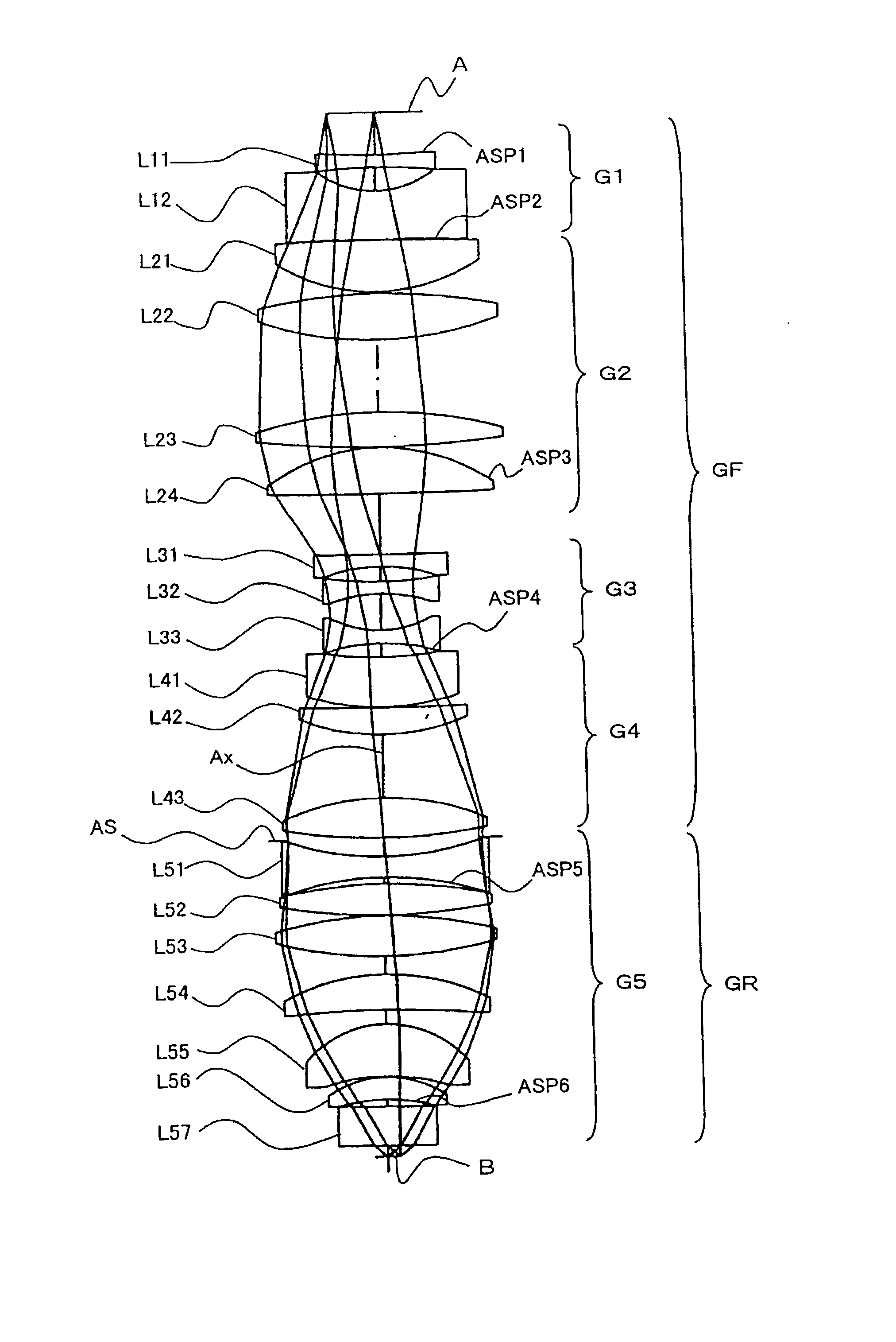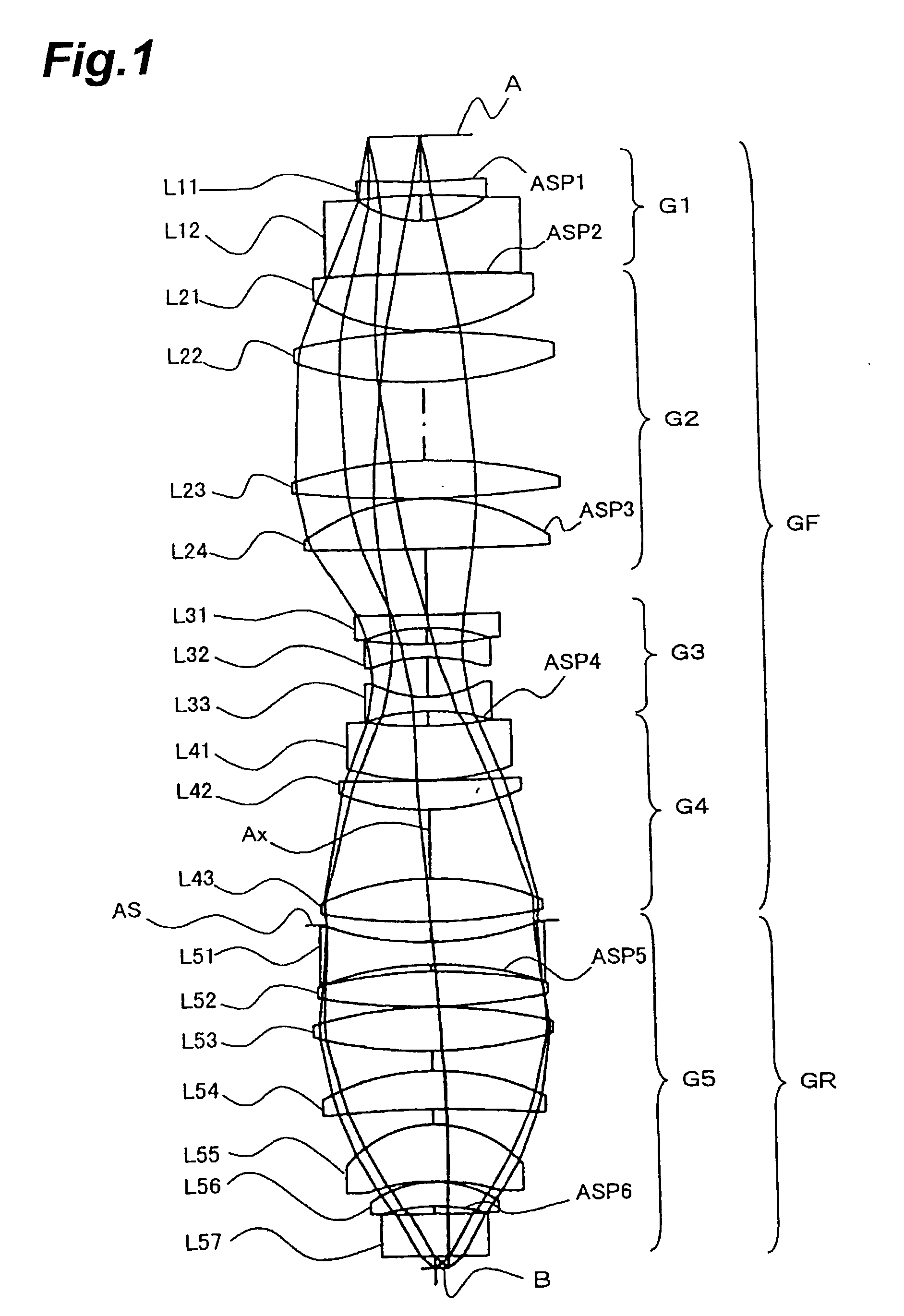Projection exposure methods and apparatus, and projection optical systems
a technology of projection optical system and projection exposure method, which is applied in the direction of photomechanical apparatus, instruments, printers, etc., can solve the problems of limited material availability, limit the practical band narrowing, and limit the application of material
- Summary
- Abstract
- Description
- Claims
- Application Information
AI Technical Summary
Benefits of technology
Problems solved by technology
Method used
Image
Examples
first embodiment
[0121] FIG. 1 is the optical path diagram of the projection optical system PL according to the
[0122] The projection optical system PL of the first embodiment uses the wavelength of 157.62 nm supplied from the band-narrowed F.sub.2 laser, as a reference wavelength and the chromatic aberration is corrected in the range of the wavelength band .+-.0.2 pm for the reference wavelength. In the first embodiment, all the radiation-transmitting refractors (lenses L11 to L57) in the projection optical system PL are made of fluorite (calcium fluoride, CaF.sub.2).
[0123] As shown in FIG. 1, the projection optical system PL of the first embodiment has the front lens unit GF of the positive refracting power, the aperture stop AS, and the rear lens unit GR of the positive refracting power in the order named from the first surface A side. According to another grouping, the projection optical system PL of the first embodiment has the negative, first lens unit G1, the positive, second lens unit G2, the...
second embodiment
[0129] FIG. 2 is the optical path diagram of the projection optical system PL according to the
[0130] The projection optical system PL of the second embodiment uses the wavelength of 193.306 nm supplied from the band-narrowed ArF laser, as a reference wavelength and implements correction for chromatic aberration in the range of the wavelength band .+-.0.4 pm for the reference wavelength. In the second embodiment, the radiation-transmitting refractors in the projection optical system PL are made of silica glass (synthetic quartz) and fluorite.
[0131] As shown in FIG. 2, the projection optical system PL of the second embodiment has the front lens unit GF of the positive refracting power, the aperture stop AS, and the rear lens unit GR of the positive refracting power in the order named from the first surface A side. According to another grouping, the projection optical system PL of the first embodiment has the negative, first lens unit G1, the positive, second lens unit G2, the negative...
##table 1 first embodiment (fig.1)
1TABLE 1 First Embodiment (FIG. 1) d0 = 40.6446 (mm) WD = 10.8134 (mm) .vertline. .beta. .vertline. = 1 / 4 NA = 0.75 .O slashed. = 23 (mm) Radius of Surface curvature distance Aspheric (mm) (mm) Glass surface Lens 1: -446.6132 12.0000 CaF.sub.2 ASP1 L11 2: 554.7232 22.5800 3: -92.3259 46.8618 CaF.sub.2 L12 4: -6695.3973 1.1105 ASP2 5: 3832.9930 50.0000 CaF.sub.2 L21 6: -179.0867 2.1599 7: 552.3099 44.4615 CaF.sub.2 L22 8: -337.8904 72.3130 9: 416.2197 34.5857 CaF.sub.2 L23 10: -885.0528 1.0000 11: 179.8393 45.7388 CaF.sub.2 ASP3 L24 12: -3356.1983 59.3145 13: -4096.8404 12.0000 CaF.sub.2 L31 14: 160.6568 14.5833 15: -317.8664 12.0000 CaF.sub.2 L32 16: 146.7839 35.8889 17: -96.9946 12.8163 CaF.sub.2 L33 18: 190.5253 13.5021 ASP4 19: -335.6495 50.0000 CaF.sub.2 L41 20: -220.3094 1.0000 21: -2196.6594 26.1615 CaF.sub.2 L42 22: -200.6039 62.7317 23: 245.0000 38.2977 CaF.sub.2 L43 24: -522.0290 1.0000 25: .infin. 17.3237 AS 26: -268.6720 20.2571 CaF.sub.2 L51 27: 312.7719 6.2767 ASP5 28: ...
PUM
 Login to View More
Login to View More Abstract
Description
Claims
Application Information
 Login to View More
Login to View More - R&D
- Intellectual Property
- Life Sciences
- Materials
- Tech Scout
- Unparalleled Data Quality
- Higher Quality Content
- 60% Fewer Hallucinations
Browse by: Latest US Patents, China's latest patents, Technical Efficacy Thesaurus, Application Domain, Technology Topic, Popular Technical Reports.
© 2025 PatSnap. All rights reserved.Legal|Privacy policy|Modern Slavery Act Transparency Statement|Sitemap|About US| Contact US: help@patsnap.com



